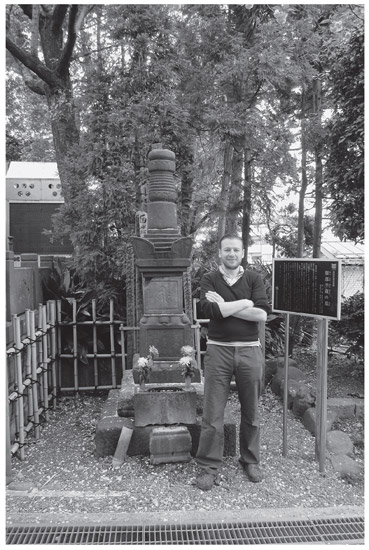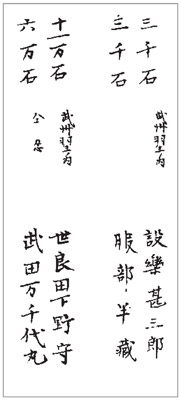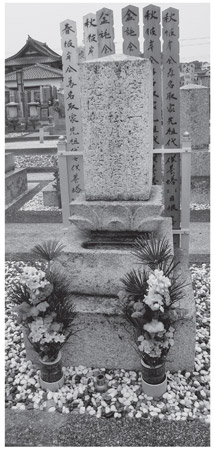In Search of the Niinja (37 page)
Read In Search of the Niinja Online
Authors: Antony Cummins





Lord Tokugawa has good men. Hattori Hanzo is the Devil Hanzo, Watanabe Hanzo is the Spear Hanzo and Atsumi Gengo is called the ‘Head Taker’ Gengo.
The ‘Hanzo’ poem

The author at the grave of Hattori Hanzo II, the Shinobi leader for Tokugawa Ieyasu.
Move evidence for a ninja connection to the Hattori family comes from the
Iga Zukesashidashi Cho,
which is a directory of Iga men and lists those available for service to their ‘parent’ domain of Tsu under the Todo family. By the time this document was written in 1636, the province of Iga had been under the control of the Damiyo regime and the Todo family for more than 50 years. The document lists those outside of the regular army who can be called upon for service if the ruling family so wishes. In one section it lists the following four groups:
•
Horo
111
Gumi-shu
(warriors of the cloak)
•
Teppo-gashira gumi
(rifle – or more accurately musket – squad captains)
•
Rusui-shu
(castle defence force for when the lord is absent)
•
Shinobi no shu
(ninja squads)
The document then goes on to say: ‘In October of the year 1636 the lord of Todo hired 20 people as a shinobi group. Within the list of 20 the name Hattori is given three times: Hattori Shichiuemon, Hattori Mozaimon and Hattori Bunzaimon. The name Hattori Mozaimon reappears, but we do not know if it is the same man or a descendant, as in the 1680s he is listed in the
Toshukai
document alongside another Hattori ninja, Hattori Gohei.

The Hanzo reward.
The
Iga Ninhi no Kan
manual was written by Hattori Yasumasa in 1624 and transcribed by Nakakura Munefumi in 1672. The manual talks of the fire skills of the ninja and most of the mixes of gunpowder are the same as described in
Bansenshukai
, which is thought to be an Iga manual. The
Iga-ryu Ninpo Gokuhi No Maki,
a manual of secret ninja skills, also mentions the Hattori family.
A strong connection of the Hattori to the ninja comes from the
Gunpo Jiyoshu
manual, as all of its contents relating to the ninja are said to have come from ‘Hattori Jibuemon and other warriors’, which the author uses in context with
Iga no mono,
implying that this Hattori is of the Iga branch.
Another interesting reference to the Hattori family can be seen in the image opposite. This is a list of battle spoils given out after the Battle of Sekigahara. On the lower row on the right hand side we see the name Hattori Hanzo, who is given 3000 Koku for his part in the war. Whilst it does not directly mention shinobi, we do know that at this time, Hattori Hanzo was the leader of a group of approximately 200
Iga no mono
. However, this Hattori Hanzo is actually the son of Hattori Hanzo II (Devil Hanzo). The son was disliked by the
Iga no Mono
of his group. Perhaps he was the cause of the first strike in Japan, as those
Iga no mono
under him supposedly refused to remain under his command. He must have been a huge disappointment to the famous Devil Hanzo, his father.
It can be concluded that the Hattori are not only connected to the ninja, but are also a powerful family. They were well known in their own time, leaving us with little doubt of their involvement in Sengoku period shinobi activities, affirming their position as ninja in our modern understanding. This leads to another ‘ninja family’, not quite as prestigious in the eyes of modern readers or as well known as the Hattori but one which has come to prominence since the publication of
True Path of the Ninja.
If it were not for a single word in the inscription attached to the ninja manual the
Shoninki,
the world would never have known that this manual was a record of the Natori family’s shinobi tactics.

The Natori family gravestone. The head stone was used for the entire family clan. This is a smaller version dated 1809.
The
Record of the History of the Kishu-Tokugawa Clan
or the
Nanki
Tokugawa Shi
document from the early Meiji Restoration was compiled from 1888–1901 and used original documents of the Kishu-Tokugawa clan (1602–1869). Whilst produced much later than the events themselves, it is an official document of the Tokugawa and should be considered as a highly reliable source, owing to its purpose and access to primary documentation. It states:
Their ancestor was a Koshu warrior, therefore they used Koshu military ways and it was named Natori-ryu. From generation to generation they were a master family of the military arts and recruited disciples; the things they did were secret, therefore the way of their school is unknown.
Now we do know the way of their school, as their secret arts have been translated into English and they have given the world an insight into Japanese espionage. It is best to start with the founding of the school. The popular theory that
Natori-ryu
was born of an Iga school is wrong.
The military arts of the Natori family are based on the tactics derived from Koshu, the homeland of the famous tactician Takeda Shingen, who was a genius on the field of battle and who is strongly associated with the ninja. The origins of the skills themselves cannot be accounted for but the skills of
are based on the tactics derived from Koshu, the homeland of the famous tactician Takeda Shingen, who was a genius on the field of battle and who is strongly associated with the ninja. The origins of the skills themselves cannot be accounted for but the skills of
Natori-ryu
reach into the Sengoku period, something that many ninja schools cannot claim with certainty. What we do know is that the school was a
Gunpo
or military arts school and by the time of Natori Masatake,
Natori-ryu
was considered the third best ranking school inside the Kishu-Tokugawa clan, who were one of the three great houses of the Tokugawa regime. The order of status of the clan’s military schools is as follows:
1 | Usami-ryu | high tactics |
2 | Hashizume | manners and ways |
3 | Natori | secret military arts |
